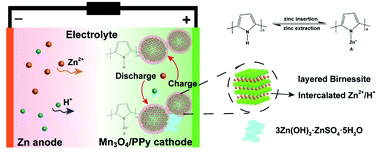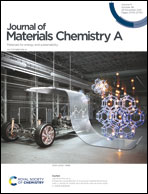Alleviated Mn2+ dissolution drives long-term cycling stability in ultrafine Mn3O4/PPy core–shell nanodots for zinc-ion batteries†
Abstract
Aqueous Zn-ion batteries (ZIBs) have garnered significant attention regarding the growing demand for electrical energy, owing to their decent electrochemical performance, operational safety, low cost and environmental friendliness. However, optimization of cathode materials is still an issue and opportunity facing aqueous ZIBs. Organic coating is a common strategy to modify other types of cathode materials through the synergistic effect. Here, we synthesized a series of ultrafine Mn3O4/polypyrrole core–shell nanodot composites (Mn3O4/PPy) through an in situ polymerization strategy. The PPy content in this core–shell structure was continuously tuned by adjusting the pyrrole addition during self-polymerization. An optimized Mn3O4/PPy core–shell cathode with a PPy ratio of 14.6 wt% delivers a high capacity (332.5 mA h g−1 at 0.1 A g−1) and excellent rate performance (141.7 mA h g−1 at 1 A g−1). More importantly, Mn3O4/PPy shows superior long-term cycling stability over 1500 cycles (with a high capacity retention of 92.5% at 1.0 A g−1), which is almost three times longer than that of pristine Mn3O4 nanodots. We have clarified that the improvement in long-term cycling stability is attributed to the increased electron/ion conductivity, alleviated Mn2+ dissolution and enhanced structural stability caused by PPy coating.



 Please wait while we load your content...
Please wait while we load your content...